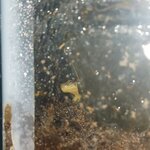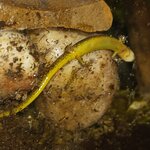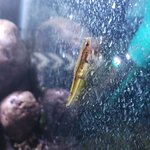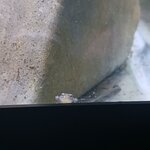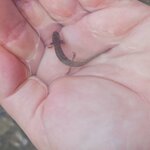OliveSings
New member
- Joined
- Jan 6, 2024
- Messages
- 2
- Reaction score
- 0
- Points
- 1
- Location
- East Coast US
- Country
- United States
I’ve read the caudataculture care sheets and lots of other information but still have a few remaining questions. I have two wild caught lead phase redbacks found in a crack in our driveway. They are in a partially set-up tank (partially cuz we didn’t really plan this and I know ideally we would have the tank properly cycled and all). It’s been about 3-4 weeks and they seem to be doing…fine? Or at least, no obvious illness or weight loss, and they eat.
Deets on the tank:
…5.5 g glass aquarium (on small side but the sals seem to be paired since they were found snuggled together with no other sals around, and still snuggle on occasion)
…70-90% humidity on average, 60-65 deg F
…DIY screen lid with removable sliding plexiglass that covers about half the screen
…Substrate is approximately 2/3-3/4 coco coir, 1/4 standard indoor potting soil, a few handfuls of perlite and pumice
…Plants include mood moss, frosty fern, and pothos
…Two 12” Barrina T5 LED lights on 12 hour cycle
…Two 2” pot “hides”
…A tiny bit of leaf litter but will be adding more
1. I haven’t “cleaned” their tank cuz I hardly ever see any poop. I *do* pick up dead bugs they haven’t eaten, but that’s mostly it so far. I haven’t even added cleanup crew yet (believe me, I’m still trying). Am I doing something wrong?
2. I’m pretty sure they have worms—see attached video for one example (EDIT: video was too large so I did a screenshot instead, sorry!) I don’t think fungus gnat larvae “whip around” in that manner, and I assume the worms are still alive, just burrowed in the soil. I saw them only once and not since then. I read this is normal in WC animals and requires no action unless they get sick. However, since their enclosure right now is kind of bare-bones, should they be treated preventatively?
3. I’ve found that the salamanders’ required temp range is below or at the lower end of many terrarium plants. All the plants in there are languishing. Are there other plants that grow (not just “survive”) in 70%+ humidity and low-mid 60s F? I’m also working on trying to get the humidity down.
4. Despite all I’ve read, I still don’t have a good idea of how much and how frequently to feed them. The most clear guidelines I’ve come across said to feed however much they can eat in 10 minutes, every 2-3 days. But they don’t usually come out to eat, I can only go by how much is leftover the following day, and even then, the mealworms probably all burrowed into the soil and the fruit flies are so tiny that it’s hard to tell how much is leftover. God knows where the one earthworm I put in there went.
4. Will springtails and isopods maintain a colony at this temp range? I did manage to find *one* springtail culture—a container at a petsmart dated late October so not in great condition—but I don’t think it’s thriving enough to put in the tank yet. There’s a good number of them but it’s not all-out infestation dense like the pics I see online. Is it supposed to look like that before adding them to the enclosure?
5. They sometimes seem overly docile bordering on lethargic. I freaked out at first, but they’ve been like that from the beginning, and 2 other redbacks that the kids caught in different parts of our yard on different days were totally the same way (those were both let go). Our neighborhood is about as urban as you can get in a mid-Atlantic metro area and still have a house with a yard. So finding salamanders, even a species that is probably boring to people on this website, was totally shocking to us. It’s not like what Ive read where someone lifts a log in the middle of a forest and there’s dozens. Should I still be concerned? Do urban red backs behave differently? Have they all been mildly poisoned by urban runoff?
Thank you for reading and apologies for the long post!!

Deets on the tank:
…5.5 g glass aquarium (on small side but the sals seem to be paired since they were found snuggled together with no other sals around, and still snuggle on occasion)
…70-90% humidity on average, 60-65 deg F
…DIY screen lid with removable sliding plexiglass that covers about half the screen
…Substrate is approximately 2/3-3/4 coco coir, 1/4 standard indoor potting soil, a few handfuls of perlite and pumice
…Plants include mood moss, frosty fern, and pothos
…Two 12” Barrina T5 LED lights on 12 hour cycle
…Two 2” pot “hides”
…A tiny bit of leaf litter but will be adding more
1. I haven’t “cleaned” their tank cuz I hardly ever see any poop. I *do* pick up dead bugs they haven’t eaten, but that’s mostly it so far. I haven’t even added cleanup crew yet (believe me, I’m still trying). Am I doing something wrong?
2. I’m pretty sure they have worms—see attached video for one example (EDIT: video was too large so I did a screenshot instead, sorry!) I don’t think fungus gnat larvae “whip around” in that manner, and I assume the worms are still alive, just burrowed in the soil. I saw them only once and not since then. I read this is normal in WC animals and requires no action unless they get sick. However, since their enclosure right now is kind of bare-bones, should they be treated preventatively?
3. I’ve found that the salamanders’ required temp range is below or at the lower end of many terrarium plants. All the plants in there are languishing. Are there other plants that grow (not just “survive”) in 70%+ humidity and low-mid 60s F? I’m also working on trying to get the humidity down.
4. Despite all I’ve read, I still don’t have a good idea of how much and how frequently to feed them. The most clear guidelines I’ve come across said to feed however much they can eat in 10 minutes, every 2-3 days. But they don’t usually come out to eat, I can only go by how much is leftover the following day, and even then, the mealworms probably all burrowed into the soil and the fruit flies are so tiny that it’s hard to tell how much is leftover. God knows where the one earthworm I put in there went.
4. Will springtails and isopods maintain a colony at this temp range? I did manage to find *one* springtail culture—a container at a petsmart dated late October so not in great condition—but I don’t think it’s thriving enough to put in the tank yet. There’s a good number of them but it’s not all-out infestation dense like the pics I see online. Is it supposed to look like that before adding them to the enclosure?
5. They sometimes seem overly docile bordering on lethargic. I freaked out at first, but they’ve been like that from the beginning, and 2 other redbacks that the kids caught in different parts of our yard on different days were totally the same way (those were both let go). Our neighborhood is about as urban as you can get in a mid-Atlantic metro area and still have a house with a yard. So finding salamanders, even a species that is probably boring to people on this website, was totally shocking to us. It’s not like what Ive read where someone lifts a log in the middle of a forest and there’s dozens. Should I still be concerned? Do urban red backs behave differently? Have they all been mildly poisoned by urban runoff?
Thank you for reading and apologies for the long post!!

